[English] 日本語
 Yorodumi
Yorodumi- PDB-7mey: Structure of yeast Ubr1 in complex with Ubc2 and monoubiquitinate... -
+ Open data
Open data
- Basic information
Basic information
| Entry | Database: PDB / ID: 7mey | ||||||
|---|---|---|---|---|---|---|---|
| Title | Structure of yeast Ubr1 in complex with Ubc2 and monoubiquitinated N-degron | ||||||
 Components Components |
| ||||||
 Keywords Keywords |  TRANSFERASE / Ubiquitin E3 ligase / TRANSFERASE / Ubiquitin E3 ligase /  ubiquitination / ubiquitination /  Ubr1 / Ubc2 / Ubr1 / Ubc2 /  Degron / Degron /  N-end rule N-end rule | ||||||
| Function / homology |  Function and homology information Function and homology informationMUB1-RAD6-UBR2 ubiquitin ligase complex / RAD6-UBR2 ubiquitin ligase complex / Rad6-Rad18 complex / regulation of dipeptide transport / UBR1-RAD6 ubiquitin ligase complex /  HULC complex / error-free postreplication DNA repair / proteasome regulatory particle binding / stress-induced homeostatically regulated protein degradation pathway / ubiquitin-dependent protein catabolic process via the N-end rule pathway ...MUB1-RAD6-UBR2 ubiquitin ligase complex / RAD6-UBR2 ubiquitin ligase complex / Rad6-Rad18 complex / regulation of dipeptide transport / UBR1-RAD6 ubiquitin ligase complex / HULC complex / error-free postreplication DNA repair / proteasome regulatory particle binding / stress-induced homeostatically regulated protein degradation pathway / ubiquitin-dependent protein catabolic process via the N-end rule pathway ...MUB1-RAD6-UBR2 ubiquitin ligase complex / RAD6-UBR2 ubiquitin ligase complex / Rad6-Rad18 complex / regulation of dipeptide transport / UBR1-RAD6 ubiquitin ligase complex /  HULC complex / error-free postreplication DNA repair / proteasome regulatory particle binding / stress-induced homeostatically regulated protein degradation pathway / ubiquitin-dependent protein catabolic process via the N-end rule pathway / meiotic DNA double-strand break formation / HULC complex / error-free postreplication DNA repair / proteasome regulatory particle binding / stress-induced homeostatically regulated protein degradation pathway / ubiquitin-dependent protein catabolic process via the N-end rule pathway / meiotic DNA double-strand break formation /  cytoplasm protein quality control by the ubiquitin-proteasome system / mitochondria-associated ubiquitin-dependent protein catabolic process / Antigen processing: Ubiquitination & Proteasome degradation / telomere maintenance via recombination / proteasome regulatory particle, base subcomplex / ribosome-associated ubiquitin-dependent protein catabolic process / hypothalamus gonadotrophin-releasing hormone neuron development / female meiosis I / positive regulation of protein monoubiquitination / mitochondrion transport along microtubule / cytoplasm protein quality control by the ubiquitin-proteasome system / mitochondria-associated ubiquitin-dependent protein catabolic process / Antigen processing: Ubiquitination & Proteasome degradation / telomere maintenance via recombination / proteasome regulatory particle, base subcomplex / ribosome-associated ubiquitin-dependent protein catabolic process / hypothalamus gonadotrophin-releasing hormone neuron development / female meiosis I / positive regulation of protein monoubiquitination / mitochondrion transport along microtubule /  E2 ubiquitin-conjugating enzyme / fat pad development / DNA duplex unwinding / sporulation resulting in formation of a cellular spore / error-free translesion synthesis / female gonad development / E2 ubiquitin-conjugating enzyme / fat pad development / DNA duplex unwinding / sporulation resulting in formation of a cellular spore / error-free translesion synthesis / female gonad development /  proteasome binding / seminiferous tubule development / male meiosis I / protein monoubiquitination / ubiquitin conjugating enzyme activity / positive regulation of intrinsic apoptotic signaling pathway by p53 class mediator / subtelomeric heterochromatin formation / error-prone translesion synthesis / proteasome binding / seminiferous tubule development / male meiosis I / protein monoubiquitination / ubiquitin conjugating enzyme activity / positive regulation of intrinsic apoptotic signaling pathway by p53 class mediator / subtelomeric heterochromatin formation / error-prone translesion synthesis /  ubiquitin ligase complex / ubiquitin ligase complex /  energy homeostasis / regulation of neuron apoptotic process / : / regulation of proteasomal protein catabolic process / Maturation of protein E / Maturation of protein E / ER Quality Control Compartment (ERQC) / Myoclonic epilepsy of Lafora / FLT3 signaling by CBL mutants / Prevention of phagosomal-lysosomal fusion / IRAK2 mediated activation of TAK1 complex / Alpha-protein kinase 1 signaling pathway / energy homeostasis / regulation of neuron apoptotic process / : / regulation of proteasomal protein catabolic process / Maturation of protein E / Maturation of protein E / ER Quality Control Compartment (ERQC) / Myoclonic epilepsy of Lafora / FLT3 signaling by CBL mutants / Prevention of phagosomal-lysosomal fusion / IRAK2 mediated activation of TAK1 complex / Alpha-protein kinase 1 signaling pathway /  Glycogen synthesis / IRAK1 recruits IKK complex / IRAK1 recruits IKK complex upon TLR7/8 or 9 stimulation / Membrane binding and targetting of GAG proteins / Constitutive Signaling by NOTCH1 HD Domain Mutants / mitotic G1 DNA damage checkpoint signaling / Endosomal Sorting Complex Required For Transport (ESCRT) / NOTCH2 Activation and Transmission of Signal to the Nucleus / IRAK2 mediated activation of TAK1 complex upon TLR7/8 or 9 stimulation / PTK6 Regulates RTKs and Their Effectors AKT1 and DOK1 / Negative regulation of FLT3 / Regulation of FZD by ubiquitination / TICAM1,TRAF6-dependent induction of TAK1 complex / TICAM1-dependent activation of IRF3/IRF7 / APC/C:Cdc20 mediated degradation of Cyclin B / p75NTR recruits signalling complexes / Downregulation of ERBB4 signaling / TRAF6 mediated IRF7 activation in TLR7/8 or 9 signaling / APC-Cdc20 mediated degradation of Nek2A / PINK1-PRKN Mediated Mitophagy / TRAF6-mediated induction of TAK1 complex within TLR4 complex / Pexophagy / InlA-mediated entry of Listeria monocytogenes into host cells / Regulation of innate immune responses to cytosolic DNA / VLDLR internalisation and degradation / Downregulation of ERBB2:ERBB3 signaling / NRIF signals cell death from the nucleus / Activated NOTCH1 Transmits Signal to the Nucleus / NF-kB is activated and signals survival / Regulation of PTEN localization / Glycogen synthesis / IRAK1 recruits IKK complex / IRAK1 recruits IKK complex upon TLR7/8 or 9 stimulation / Membrane binding and targetting of GAG proteins / Constitutive Signaling by NOTCH1 HD Domain Mutants / mitotic G1 DNA damage checkpoint signaling / Endosomal Sorting Complex Required For Transport (ESCRT) / NOTCH2 Activation and Transmission of Signal to the Nucleus / IRAK2 mediated activation of TAK1 complex upon TLR7/8 or 9 stimulation / PTK6 Regulates RTKs and Their Effectors AKT1 and DOK1 / Negative regulation of FLT3 / Regulation of FZD by ubiquitination / TICAM1,TRAF6-dependent induction of TAK1 complex / TICAM1-dependent activation of IRF3/IRF7 / APC/C:Cdc20 mediated degradation of Cyclin B / p75NTR recruits signalling complexes / Downregulation of ERBB4 signaling / TRAF6 mediated IRF7 activation in TLR7/8 or 9 signaling / APC-Cdc20 mediated degradation of Nek2A / PINK1-PRKN Mediated Mitophagy / TRAF6-mediated induction of TAK1 complex within TLR4 complex / Pexophagy / InlA-mediated entry of Listeria monocytogenes into host cells / Regulation of innate immune responses to cytosolic DNA / VLDLR internalisation and degradation / Downregulation of ERBB2:ERBB3 signaling / NRIF signals cell death from the nucleus / Activated NOTCH1 Transmits Signal to the Nucleus / NF-kB is activated and signals survival / Regulation of PTEN localization /  Regulation of BACH1 activity / Translesion synthesis by REV1 / Synthesis of active ubiquitin: roles of E1 and E2 enzymes / Translesion synthesis by POLK / MAP3K8 (TPL2)-dependent MAPK1/3 activation / TICAM1, RIP1-mediated IKK complex recruitment / Gap-filling DNA repair synthesis and ligation in GG-NER / Downregulation of TGF-beta receptor signaling / Translesion synthesis by POLI / Josephin domain DUBs / Activation of IRF3, IRF7 mediated by TBK1, IKKε (IKBKE) / Regulation of activated PAK-2p34 by proteasome mediated degradation / neuron projection morphogenesis / InlB-mediated entry of Listeria monocytogenes into host cell / IKK complex recruitment mediated by RIP1 / JNK (c-Jun kinases) phosphorylation and activation mediated by activated human TAK1 / regulation of mitochondrial membrane potential / TGF-beta receptor signaling in EMT (epithelial to mesenchymal transition) / N-glycan trimming in the ER and Calnexin/Calreticulin cycle / Autodegradation of Cdh1 by Cdh1:APC/C / TNFR1-induced NF-kappa-B signaling pathway / APC/C:Cdc20 mediated degradation of Securin Regulation of BACH1 activity / Translesion synthesis by REV1 / Synthesis of active ubiquitin: roles of E1 and E2 enzymes / Translesion synthesis by POLK / MAP3K8 (TPL2)-dependent MAPK1/3 activation / TICAM1, RIP1-mediated IKK complex recruitment / Gap-filling DNA repair synthesis and ligation in GG-NER / Downregulation of TGF-beta receptor signaling / Translesion synthesis by POLI / Josephin domain DUBs / Activation of IRF3, IRF7 mediated by TBK1, IKKε (IKBKE) / Regulation of activated PAK-2p34 by proteasome mediated degradation / neuron projection morphogenesis / InlB-mediated entry of Listeria monocytogenes into host cell / IKK complex recruitment mediated by RIP1 / JNK (c-Jun kinases) phosphorylation and activation mediated by activated human TAK1 / regulation of mitochondrial membrane potential / TGF-beta receptor signaling in EMT (epithelial to mesenchymal transition) / N-glycan trimming in the ER and Calnexin/Calreticulin cycle / Autodegradation of Cdh1 by Cdh1:APC/C / TNFR1-induced NF-kappa-B signaling pathway / APC/C:Cdc20 mediated degradation of SecurinSimilarity search - Function | ||||||
| Biological species |   Saccharomyces cerevisiae (brewer's yeast) Saccharomyces cerevisiae (brewer's yeast)  Homo sapiens (human) Homo sapiens (human)  Saccharomyces cerevisiae S288C (yeast) Saccharomyces cerevisiae S288C (yeast) | ||||||
| Method |  ELECTRON MICROSCOPY / ELECTRON MICROSCOPY /  single particle reconstruction / single particle reconstruction /  cryo EM / Resolution: 3.67 Å cryo EM / Resolution: 3.67 Å | ||||||
 Authors Authors | Pan, M. / Zheng, Q. / Wang, T. / Liang, L. / Yu, Y. / Liu, L. / Zhao, M. | ||||||
| Funding support | 1items
| ||||||
 Citation Citation |  Journal: Nature / Year: 2021 Journal: Nature / Year: 2021Title: Structural insights into Ubr1-mediated N-degron polyubiquitination. Authors: Man Pan / Qingyun Zheng / Tian Wang / Lujun Liang / Junxiong Mao / Chong Zuo / Ruichao Ding / Huasong Ai / Yuan Xie / Dong Si / Yuanyuan Yu / Lei Liu / Minglei Zhao /   Abstract: The N-degron pathway targets proteins that bear a destabilizing residue at the N terminus for proteasome-dependent degradation. In yeast, Ubr1-a single-subunit E3 ligase-is responsible for the Arg/N- ...The N-degron pathway targets proteins that bear a destabilizing residue at the N terminus for proteasome-dependent degradation. In yeast, Ubr1-a single-subunit E3 ligase-is responsible for the Arg/N-degron pathway. How Ubr1 mediates the initiation of ubiquitination and the elongation of the ubiquitin chain in a linkage-specific manner through a single E2 ubiquitin-conjugating enzyme (Ubc2) remains unknown. Here we developed chemical strategies to mimic the reaction intermediates of the first and second ubiquitin transfer steps, and determined the cryo-electron microscopy structures of Ubr1 in complex with Ubc2, ubiquitin and two N-degron peptides, representing the initiation and elongation steps of ubiquitination. Key structural elements, including a Ubc2-binding region and an acceptor ubiquitin-binding loop on Ubr1, were identified and characterized. These structures provide mechanistic insights into the initiation and elongation of ubiquitination catalysed by Ubr1. | ||||||
| History |
|
- Structure visualization
Structure visualization
| Movie |
 Movie viewer Movie viewer |
|---|---|
| Structure viewer | Molecule:  Molmil Molmil Jmol/JSmol Jmol/JSmol |
- Downloads & links
Downloads & links
- Download
Download
| PDBx/mmCIF format |  7mey.cif.gz 7mey.cif.gz | 373.3 KB | Display |  PDBx/mmCIF format PDBx/mmCIF format |
|---|---|---|---|---|
| PDB format |  pdb7mey.ent.gz pdb7mey.ent.gz | 304.8 KB | Display |  PDB format PDB format |
| PDBx/mmJSON format |  7mey.json.gz 7mey.json.gz | Tree view |  PDBx/mmJSON format PDBx/mmJSON format | |
| Others |  Other downloads Other downloads |
-Validation report
| Arichive directory |  https://data.pdbj.org/pub/pdb/validation_reports/me/7mey https://data.pdbj.org/pub/pdb/validation_reports/me/7mey ftp://data.pdbj.org/pub/pdb/validation_reports/me/7mey ftp://data.pdbj.org/pub/pdb/validation_reports/me/7mey | HTTPS FTP |
|---|
-Related structure data
| Related structure data |  23807MC  7mexC M: map data used to model this data C: citing same article ( |
|---|---|
| Similar structure data | |
| EM raw data |  EMPIAR-10902 (Title: Single-particle cryoEM data of yeast Ubr1-Ubc2-Ub-Ub-N-degron complex (elongation) EMPIAR-10902 (Title: Single-particle cryoEM data of yeast Ubr1-Ubc2-Ub-Ub-N-degron complex (elongation)Data size: 2.9 TB Data #1: Unaligned movie data of yeast Ubr1-Ubc2-Ub-Ub-N-degron complex (elongation complex) [micrographs - multiframe]) |
- Links
Links
- Assembly
Assembly
| Deposited unit | 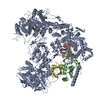
|
|---|---|
| 1 |
|
- Components
Components
-Protein , 4 types, 4 molecules ACBD
| #1: Protein | Mass: 225102.750 Da / Num. of mol.: 1 Source method: isolated from a genetically manipulated source Source: (gene. exp.)   Saccharomyces cerevisiae (strain ATCC 204508 / S288c) (yeast) Saccharomyces cerevisiae (strain ATCC 204508 / S288c) (yeast)Strain: ATCC 204508 / S288c / Gene: UBR1, PTR1, YGR184C, G7168 / Plasmid: p416CYC / Production host:   Saccharomyces cerevisiae S288C (yeast) Saccharomyces cerevisiae S288C (yeast)References: UniProt: P19812, RING-type E3 ubiquitin transferase |
|---|---|
| #2: Protein |  Mass: 8493.741 Da / Num. of mol.: 1 / Fragment: K48C Source method: isolated from a genetically manipulated source Source: (gene. exp.)   Homo sapiens (human) / Gene: UBB / Production host: Homo sapiens (human) / Gene: UBB / Production host:   Homo sapiens (human) / References: UniProt: P0CG47 Homo sapiens (human) / References: UniProt: P0CG47 |
| #3: Protein | Mass: 19725.662 Da / Num. of mol.: 1 Source method: isolated from a genetically manipulated source Source: (gene. exp.)   Saccharomyces cerevisiae (strain ATCC 204508 / S288c) (yeast) Saccharomyces cerevisiae (strain ATCC 204508 / S288c) (yeast)Strain: ATCC 204508 / S288c / Gene: RAD6, UBC2, YGL058W / Production host:   Escherichia coli (E. coli) Escherichia coli (E. coli)References: UniProt: P06104,  E2 ubiquitin-conjugating enzyme E2 ubiquitin-conjugating enzyme |
| #4: Protein |  Mass: 8519.778 Da / Num. of mol.: 1 Source method: isolated from a genetically manipulated source Source: (gene. exp.)   Homo sapiens (human) / Gene: UBB / Production host: Homo sapiens (human) / Gene: UBB / Production host:   Escherichia coli (E. coli) / References: UniProt: P0CG47 Escherichia coli (E. coli) / References: UniProt: P0CG47 |
-Protein/peptide , 1 types, 1 molecules F
| #5: Protein/peptide | Mass: 4571.223 Da / Num. of mol.: 1 / Source method: obtained synthetically / Source: (synth.)   Saccharomyces cerevisiae S288C (yeast) Saccharomyces cerevisiae S288C (yeast) |
|---|
-Non-polymers , 2 types, 8 molecules 


| #6: Chemical | ChemComp-ZN / #7: Chemical | ChemComp-Z3V / | |
|---|
-Details
| Has ligand of interest | Y |
|---|
-Experimental details
-Experiment
| Experiment | Method:  ELECTRON MICROSCOPY ELECTRON MICROSCOPY |
|---|---|
| EM experiment | Aggregation state: PARTICLE / 3D reconstruction method:  single particle reconstruction single particle reconstruction |
- Sample preparation
Sample preparation
| Component | Name: yeast Ubr1 in complex with Ubc2 and monoubiquitinated N-degron Type: COMPLEX / Entity ID: #1-#5 / Source: MULTIPLE SOURCES |
|---|---|
| Molecular weight | Experimental value: NO |
| Source (natural) | Organism:   Saccharomyces cerevisiae (strain ATCC 204508 / S288c) (yeast) Saccharomyces cerevisiae (strain ATCC 204508 / S288c) (yeast) |
| Buffer solution | pH: 8 |
| Specimen | Embedding applied: NO / Shadowing applied: NO / Staining applied : NO / Vitrification applied : NO / Vitrification applied : YES : YES |
Vitrification | Cryogen name: ETHANE |
- Electron microscopy imaging
Electron microscopy imaging
| Experimental equipment |  Model: Titan Krios / Image courtesy: FEI Company |
|---|---|
| Microscopy | Model: FEI TITAN KRIOS |
| Electron gun | Electron source : :  FIELD EMISSION GUN / Accelerating voltage: 300 kV / Illumination mode: FLOOD BEAM FIELD EMISSION GUN / Accelerating voltage: 300 kV / Illumination mode: FLOOD BEAM |
| Electron lens | Mode: BRIGHT FIELD Bright-field microscopy / Cs Bright-field microscopy / Cs : 2.7 mm / C2 aperture diameter: 70 µm : 2.7 mm / C2 aperture diameter: 70 µm |
| Image recording | Electron dose: 48 e/Å2 / Film or detector model: GATAN K3 (6k x 4k) |
- Processing
Processing
| Software | Name: PHENIX / Version: 1.19.2_4158: / Classification: refinement | ||||||||||||||||||||||||||||||||
|---|---|---|---|---|---|---|---|---|---|---|---|---|---|---|---|---|---|---|---|---|---|---|---|---|---|---|---|---|---|---|---|---|---|
| EM software |
| ||||||||||||||||||||||||||||||||
CTF correction | Type: PHASE FLIPPING ONLY | ||||||||||||||||||||||||||||||||
| Symmetry | Point symmetry : C1 (asymmetric) : C1 (asymmetric) | ||||||||||||||||||||||||||||||||
3D reconstruction | Resolution: 3.67 Å / Resolution method: FSC 0.143 CUT-OFF / Num. of particles: 65088 / Symmetry type: POINT | ||||||||||||||||||||||||||||||||
| Atomic model building | Protocol: AB INITIO MODEL / Space: REAL | ||||||||||||||||||||||||||||||||
| Refine LS restraints |
|
 Movie
Movie Controller
Controller





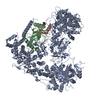
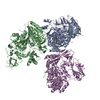
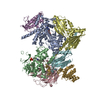

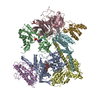
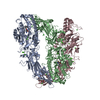
 PDBj
PDBj





















